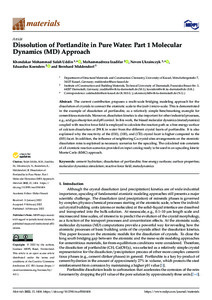Datum
2022-02-14Autor
Salah Uddin, Khondakar MohammadIzadifar, MohammadrezaUkrainczyk, NevenKoenders, EduardusMiddendorf, BernhardSchlagwort
660 Chemische Verfahrenstechnik, Technische Chemie ZementHydratationCalciumhydroxidOberflächeneigenschaftMolekulardynamikSimulationMetadata
Zur Langanzeige
Aufsatz

Dissolution of Portlandite in Pure Water: Part 1 Molecular Dynamics (MD) Approach
Zusammenfassung
The current contribution proposes a multi-scale bridging modeling approach for the dissolution of crystals to connect the atomistic scale to the (sub-) micro-scale. This is demonstrated in the example of dissolution of portlandite, as a relatively simple benchmarking example for cementitious materials. Moreover, dissolution kinetics is also important for other industrial processes, e.g., acid gas absorption and pH control. In this work, the biased molecular dynamics (metadynamics) coupled with reactive force field is employed to calculate the reaction path as a free energy surface of calcium dissolution at 298 K in water from the different crystal facets of portlandite. It is also explained why the reactivity of the (010), (100), and (11¯0) crystal facet is higher compared to the (001) facet. In addition, the influence of neighboring Ca crystal sites arrangements on the atomistic dissolution rates is explained as necessary scenarios for the upscaling. The calculated rate constants of all atomistic reaction scenarios provided an input catalog ready to be used in an upscaling kinetic Monte Carlo (KMC) approach.
Zitierform
In: Materials Volume 15 / Issue 4 (2022-02-14) eissn:1996-1944Förderhinweis
Gefördert durch den Publikationsfonds der Universität KasselZitieren
@article{doi:10.17170/kobra-202204216064,
author={Salah Uddin, Khondakar Mohammad and Izadifar, Mohammadreza and Ukrainczyk, Neven and Koenders, Eduardus and Middendorf, Bernhard},
title={Dissolution of Portlandite in Pure Water: Part 1 Molecular Dynamics (MD) Approach},
journal={Materials},
year={2022}
}
0500 Oax
0501 Text $btxt$2rdacontent
0502 Computermedien $bc$2rdacarrier
1100 2022$n2022
1500 1/eng
2050 ##0##http://hdl.handle.net/123456789/13781
3000 Salah Uddin, Khondakar Mohammad
3010 Izadifar, Mohammadreza
3010 Ukrainczyk, Neven
3010 Koenders, Eduardus
3010 Middendorf, Bernhard
4000 Dissolution of Portlandite in Pure Water: Part 1 Molecular Dynamics (MD) Approach / Salah Uddin, Khondakar Mohammad
4030
4060 Online-Ressource
4085 ##0##=u http://nbn-resolving.de/http://hdl.handle.net/123456789/13781=x R
4204 \$dAufsatz
4170
5550 {{Zement}}
5550 {{Hydratation}}
5550 {{Calciumhydroxid}}
5550 {{Oberflächeneigenschaft}}
5550 {{Molekulardynamik}}
5550 {{Simulation}}
7136 ##0##http://hdl.handle.net/123456789/13781
<resource xsi:schemaLocation="http://datacite.org/schema/kernel-2.2 http://schema.datacite.org/meta/kernel-2.2/metadata.xsd"> 2022-04-25T16:18:10Z 2022-04-25T16:18:10Z 2022-02-14 doi:10.17170/kobra-202204216064 http://hdl.handle.net/123456789/13781 Gefördert durch den Publikationsfonds der Universität Kassel eng Namensnennung 4.0 International http://creativecommons.org/licenses/by/4.0/ cement hydration dissolution of portlandite free energy surfaces surface properties molecular dynamics simulation reactive force field metadynamics 660 Dissolution of Portlandite in Pure Water: Part 1 Molecular Dynamics (MD) Approach Aufsatz The current contribution proposes a multi-scale bridging modeling approach for the dissolution of crystals to connect the atomistic scale to the (sub-) micro-scale. This is demonstrated in the example of dissolution of portlandite, as a relatively simple benchmarking example for cementitious materials. Moreover, dissolution kinetics is also important for other industrial processes, e.g., acid gas absorption and pH control. In this work, the biased molecular dynamics (metadynamics) coupled with reactive force field is employed to calculate the reaction path as a free energy surface of calcium dissolution at 298 K in water from the different crystal facets of portlandite. It is also explained why the reactivity of the (010), (100), and (11¯0) crystal facet is higher compared to the (001) facet. In addition, the influence of neighboring Ca crystal sites arrangements on the atomistic dissolution rates is explained as necessary scenarios for the upscaling. The calculated rate constants of all atomistic reaction scenarios provided an input catalog ready to be used in an upscaling kinetic Monte Carlo (KMC) approach. open access Salah Uddin, Khondakar Mohammad Izadifar, Mohammadreza Ukrainczyk, Neven Koenders, Eduardus Middendorf, Bernhard doi:10.3390/ma15041404 Zement Hydratation Calciumhydroxid Oberflächeneigenschaft Molekulardynamik Simulation publishedVersion eissn:1996-1944 Issue 4 Materials Volume 15 false 1404 </resource>
Die folgenden Lizenzbestimmungen sind mit dieser Ressource verbunden:


